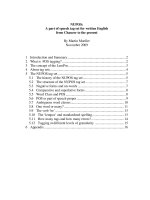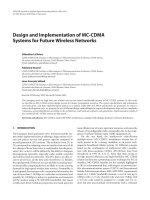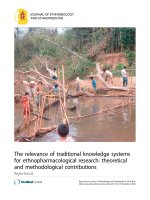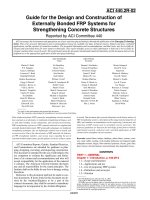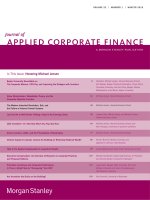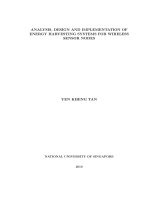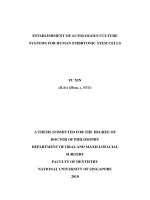Behavior of FRP repairstrengthening systems for prestressed concrete
Bạn đang xem bản rút gọn của tài liệu. Xem và tải ngay bản đầy đủ của tài liệu tại đây (20.95 MB, 402 trang )
ABSTRACT
ROSENBOOM, OWEN ARTHUR. Behavior of FRP Repair/Strengthening
Systems for Prestressed Concrete. (Under the direction of Dr. Sami
Rizkalla.)
This research study examines the behavior of prestressed concrete beams retrofitted with Fiber
Reinforced Polymer (FRP) materials. Due to deficiencies in the built environment, engineers
may be asked to retrofit or upgrade the capacity of an existing concrete structural member.
This could be a result of new demands on the structure, or a repair of damage from an
unforeseen event. Retrofits are possible using the traditional building materials of concrete
and steel. The cross-section of the structural element can be increased, or steel plates can be
bolted or adhesively affixed to the structure to increase capacity. Many of these techniques are
costly, and some perform poorly under service conditions. The main benefit for using FRP
materials for the strengthening of existing structures is the lightweight nature of the composite
material, which makes the use of extensive scaffolding (required in the installation of steel
plates) obsolete. The objectives of this research are twofold. First, the overall structural
behavior of an FRP strengthened or repaired concrete beam is studied. Two different loading
conditions are examined: extreme loading simulated by a monotonic load to failure, and
fatigue loading designed to simulate service loads. The structural behavior of the system is
evaluated under these different conditions, and an analytical model is presented which predicts
the flexural behavior of the system assuming certain failure modes. The second objective of
this research is to evaluate the bond behavior of an FRP strengthened reinforced or prestressed
concrete flexural member. A database of experimental failures was constructed, and an
analytical model is proposed which predicts the bond failure of the FRP strengthening system.
BEHAVIOR OF FRP REPAIR/STRENGTHENING SYSTEMS
FOR PRESTRESSED CONCRETE
By
Owen Arthur Rosenboom
A dissertation submitted to the Graduate Faculty of
North Carolina State University
in partial fulfillment of the
requirements for the degree of
Doctor of Philosophy
Civil Engineering
Raleigh
2006
Approved by:
___________________________
___________________________
Dr. Sami Rizkalla
Chair of Advisory Committee
Civil Engineering
Dr. Mervyn Kowalsky
Advisory Committee
Civil Engineering
___________________________
___________________________
Dr. Kara Peters
Advisory Committee
Aerospace & Mechanical Engineering
Dr. Paul Zia
Advisory Committee
Civil Engineering
UMI Number: 3233054
UMI Microform 3233054
Copyright 2007 by ProQuest Information and Learning Company.
All rights reserved. This microform edition is protected against
unauthorized copying under Title 17, United States Code.
ProQuest Information and Learning Company
300 North Zeeb Road
P.O. Box 1346
Ann Arbor, MI 48106-1346
BIOGRAPHY
Owen Rosenboom completed his MSCE from North Carolina State University in 2003. Upon
completion of his current work he plans to travel to Vietnam.
ii
ACKNOWLEDGEMENTS
Structural engineering research is a group effort. Many different people from around the
United States and around the world have contributed to the work presented here. None of it,
of course, would have been possible without the near continuous supervision and mentoring of
my advisor, Dr. Sami Rizkalla. The other members of my advisory committee have also
provided valuable insight, especially Dr. Paul Zia. Several other doctoral or post-doctoral
students have made generous gifts of time and energy including Dr. Tarek Hassan, Dr.
Ronaldson Carneiro, and Mina Dawood. I had the pleasure to work with two master’s level
students on the project, Anthony Miller and Catrina Walter, whose energy helped complete
the extensive experimental program. The North Carolina Department of Transportation
funded much of this research and should be acknowledged, along with the many other
contractors, FRP manufacturers and installers that generously donated time and material,
especially Dr. Tarek Alkhrdaji from Structural Group, and Sarah Witt and Edward Fyfe from
Fyfe Corporation. The construction of the database included in this dissertation followed from
the momentum of Dr. Kent Harries from the University of Pittsburgh within ACI Committee
440’s Bond Task Group, of which I was charitably invited to become a member. And lastly, I
thank the dedicated staff of the Constructed Facilities Laboratory (Jerry Atkinson, Bill
Dunleavy, and Amy Yonai) whose help at all stages of this research has been immeasurable.
iii
TABLE OF CONTENTS
List of Figures..............................................................................................viii
List of tables................................................................................................xiii
INTRODUCTION .................................................................................................. 1
Research Objectives ........................................................................................ 4
Scope of Dissertation ....................................................................................... 4
Outline of Thesis............................................................................................ 5
PART 1: REPAIR AND STRENGTHENING ............................................ 7
CHAPTER 1: INTRODUCTION .................................................................................... 8
CHAPTER 2: BACKGROUND ................................................................................... 10
2.1 FRP Repair / Strengthening Systems............................................................. 10
Fiber Reinforced Polymer (FRP) Materials............................................................................. 10
Adhesives ................................................................................................................................ 11
2.2 Failure Mechanisms.................................................................................. 12
2.3 History of FRP Strengthening ..................................................................... 14
2.4 Reinforced Concrete Strengthened with FRP .................................................. 14
2.5 Prestressed Concrete Strengthened with FRP .................................................. 16
2.6 Near Surface Mounted Strengthening ............................................................ 17
2.7 Steel Reinforced Polymer Strengthening ........................................................ 20
2.8 Repair of Prestressed Concrete with FRP ....................................................... 20
2.9 Fatigue Behavior...................................................................................... 25
Fatigue of Constitutive Materials ............................................................................................ 25
Fatigue of Prestressed Concrete .............................................................................................. 27
Fatigue of Reinforced Concrete Strengthened with FRP......................................................... 28
2.10 Fatigue of Prestressed Concrete Strengthened with FRP ................................... 31
2.11 Durability of FRP Systems ........................................................................ 33
2.12 Design Guidelines for Concrete Retrofitted with FRP ...................................... 33
2.13 Conclusions.......................................................................................... 36
CHAPTER 3: EXPERIMENTAL PROGRAM: STRENGTHENING ......................................... 37
3.1 Test Girders........................................................................................... 38
The C-Channel Bridge............................................................................................................. 38
Girder Reinforcing .................................................................................................................. 39
Concrete .................................................................................................................................. 42
Carbon Fiber Reinforced Polymer (CFRP) Materials.............................................................. 44
Steel Reinforced Polymer (SRP) Material............................................................................... 47
3.2 Design of Strengthened Girders ................................................................... 47
3.3 Static Tests ............................................................................................ 49
Test Setup, Procedure and Instrumentation ............................................................................. 49
Control Girder ......................................................................................................................... 52
NSM Strengthened Girders ..................................................................................................... 53
Externally Bonded CFRP Strengthened Type C1 Girders....................................................... 54
Externally Bonded CFRP Strengthened Type C2 Girders....................................................... 59
Externally Bonded SRP Strengthened Type C1 Girder ........................................................... 61
3.4 Fatigue Tests .......................................................................................... 62
Test Setup, Procedure and Instrumentation ............................................................................. 62
iv
Fatigue Load Determination.................................................................................................... 63
Control Girders........................................................................................................................ 65
NSM CFRP Strengthened Girders........................................................................................... 66
Externally Bonded CFRP Strengthened Type C1 Girders....................................................... 67
Externally Bonded CFRP Strengthened Type C2 Girders....................................................... 70
Externally Bonded SRP Strengthened Type C1 Girders.......................................................... 73
CHAPTER 4: EXPERIMENTAL PROGRAM: REPAIR ..................................................... 75
4.1 Introduction........................................................................................... 75
4.2 Test Girders........................................................................................... 77
4.3 Design of Repair System ............................................................................ 82
Flexural Repair........................................................................................................................ 82
Shear Repair ............................................................................................................................ 86
4.4 Test Setup and Procedure .......................................................................... 88
Test Setup................................................................................................................................ 88
Instrumentation........................................................................................................................ 90
Loading Scheme ...................................................................................................................... 91
Fatigue Load Determination.................................................................................................... 92
4.5 AASHTO1............................................................................................. 95
4.6 AASHTO2............................................................................................. 97
4.7 AASHTO3............................................................................................. 98
4.8 AASHTO2C .........................................................................................100
4.9 AASHTO2R .........................................................................................100
CHAPTER 5: EXPERIMENTAL RESULTS AND MODELING – STRENGTHENING AND REPAIR103
5.1 Modeling..............................................................................................103
Flexural Model ...................................................................................................................... 103
Finite Element Simulations ................................................................................................... 110
Cracked Section Analysis...................................................................................................... 112
Shear Model .......................................................................................................................... 112
5.2 Results and Discussion: Strengthening ..........................................................115
C-Channel Static Tests .......................................................................................................... 116
Type C1 Girders .........................................................................................117
Type C2 Girders .........................................................................................127
C-Channel Fatigue Tests ....................................................................................................... 132
Type C1 Girders .........................................................................................133
Type C2 Girders .........................................................................................146
5.3 Results and Discussion: Repair ...................................................................153
Flexural Study ....................................................................................................................... 153
AASHTO1 ................................................................................................153
AASHTO2 ................................................................................................158
AASHTO3 ................................................................................................163
Shear Study ........................................................................................................................... 167
CHAPTER 6: COST EFFECTIVENESS AND VALUE ENGINEERING.................................... 174
6.1 C-Channel Strengthening..........................................................................174
Cost Analysis......................................................................................................................... 174
Value Engineering Analysis .................................................................................................. 178
6.2 AASHTO Repair ....................................................................................183
Cost Analysis......................................................................................................................... 183
Value Engineering Analysis .................................................................................................. 186
v
PART 2: BOND BEHAVIOR ...............................................................187
CHAPTER 7: INTRODUCTION ................................................................................ 188
CHAPTER 8: BACKGROUND ................................................................................. 190
8.1 Plate-End (PE) Debonding ........................................................................190
Interfacial Stress Models ....................................................................................................... 192
Shear Strength Models .......................................................................................................... 195
Concrete Tooth Models ......................................................................................................... 196
Experimental Studies on Plate-End Debonding..................................................................... 198
Recommendations from Code Agencies................................................................................ 198
8.3 Intermediate Crack (IC) Debonding.............................................................200
Empirical Models .................................................................................................................. 203
Mechanics Based Models ...................................................................................................... 204
Width Factor.......................................................................................................................... 210
Fracture Based Models .......................................................................................................... 211
Multiple Crack Models.......................................................................................................... 219
Recommendations from Code Agencies................................................................................ 223
8.4 Experimental Studies ...............................................................................226
IC Debonding Database......................................................................................................... 226
Experimental Studies Included in Database .......................................................................... 226
Experimental Studies not Included in Database .................................................................... 231
8.5 Failure Criteria ......................................................................................237
Mohr-Coulomb Criteria......................................................................................................... 237
Empirical Criteria .................................................................................................................. 238
8.6 Mitigation of Debonding...........................................................................239
Transverse CFRP U-wraps .................................................................................................... 240
Other Anchorage Details ....................................................................................................... 243
8.7 Conclusions ..........................................................................................244
CHAPTER 9: EXPERIMENTAL PROGRAM: BOND ...................................................... 245
9.1 Test Girders..........................................................................................245
9.2 Girder Strengthening, Test Setup, Procedure and Instrumentation .......................248
9.3 Test Descriptions: Externally Bonded Precured Strips ......................................249
9.4 Test Descriptions: Externally Bonded Wet Lay-up Sheets ..................................251
9.5 Results and Discussion .............................................................................253
Crack Width .......................................................................................................................... 254
Ultimate Load and Displacement .......................................................................................... 255
Interface Shear Stress ............................................................................................................ 256
Predicted v. Experimental ..................................................................................................... 260
CHAPTER 10: MODEL COMPARISON ...................................................................... 262
10.1 Intermediate Crack Debonding Database .....................................................262
Database Requirements ......................................................................................................... 262
10.2 Assessment of Existing IC Debonding Models ...............................................266
Models from National Codes................................................................................................. 266
Other Models......................................................................................................................... 274
Width Factor.......................................................................................................................... 286
10.3 Conclusions.........................................................................................292
CHAPTER 11: ANALYTICAL MODEL FOR IC DEBONDING ........................................... 293
11.1 Overview ...........................................................................................293
11.2 Interface Shear Stress .............................................................................294
11.3 Design Interface Shear Stress ....................................................................297
11.3 Failure Criteria.....................................................................................302
vi
11.4 Model Calibration .................................................................................304
11.5 Rupture Check.....................................................................................306
11.6 Summary of Proposed Analytical Model ......................................................309
Mean Model .......................................................................................................................... 310
Design Model ........................................................................................................................ 311
11.7 Width Effect........................................................................................311
11.8 Statistical Analysis .................................................................................314
11.9 Scope of Analytical Model .......................................................................319
CHAPTER 12: PARAMETRIC STUDY ....................................................................... 322
12.1 Applied Loading ...................................................................................322
12.2 Concrete Properties ..............................................................................324
12.3 FRP Properties.....................................................................................325
12.4 Internal Steel Properties .........................................................................327
12.5 Level of Prestress..................................................................................329
CONCLUSIONS .................................................................................................... 331
Part 1: Repair/Strengthening..........................................................................331
FRP Strengthening Experimental Program............................................................................ 331
FRP Repair Experimental Program ....................................................................................... 332
Flexural and Shear Modeling ................................................................................................ 333
Part 2: Bond Behavior...................................................................................334
Experimental Study on Bond Behavior ................................................................................. 334
Model Comparison and Database Construction .................................................................... 334
Analytical Model for IC debonding....................................................................................... 335
Future Work..............................................................................................336
FRP Strengthening and Bond Behavior................................................................................. 336
FRP Repair ............................................................................................................................ 338
REFERENCES ....................................................................................................... 340
RECOMMENDATIONS FOR THE INSTALLATION OF FRP SYSTEMS FOR CONCRETE
STRUCTURES ...................................................................................................... 352
A.1 Shipping, Storage and Handling..................................................................352
A.2 Section Restoration ................................................................................353
A.3 Surface Preparation ................................................................................355
A.4 Near Surface Mounted CFRP Installation ......................................................357
A.5 Externally Bonded Pre-cured CFRP Laminate Installation .................................357
A.6 Externally Bonded Wet Lay-up CFRP Installation ...........................................358
A.7 Use of Externally Bonded SRP ...................................................................360
DESIGN EXAMPLES.............................................................................................. 364
B.1 Reinforced Concrete Beam .......................................................................364
B.2 Prestressed Concrete Bridge Girder.............................................................372
IC DEBONDING DATABASE .................................................................................. 382
vii
LIST OF FIGURES
List of Figures
Part 1: Repair / Strengthening
Figure 1 Repair / strengthening philosophy (adapted from Carolin 2003) .................................... 1
Figure 2 Strengthening of bridges with traditional materials and composites (Meier 1986) ................ 2
Figure 3 FRP-concrete published articles............................................................................ 3
Figure 4 Summary of experimental program ....................................................................... 5
Figure 2.1 Stress-strain characteristics of steel, FRP, SRP materials...........................................11
Figure 2.2 Failure modes of FRP strengthened RC structures ..................................................13
Figure 2.1 NSM Reinforcement......................................................................................18
Figure 2.2 S-N Behavior of prestressing strands...................................................................27
Figure 2.3. Load versus displacement hysteresis (from Larson, et al.2005) ..................................32
Figure 3.1 Summary of experimental program for Strengthening Study......................................37
Figure 3.2 C-Channel Bridge Layout................................................................................38
Figure 3.3 Typical C-channel bridge. ...............................................................................39
Figure 3.4 Cross section showing prestressing strand configurations ..........................................40
Figure 3.5 Concrete core drilling operation for C-Channel girders ...........................................43
Figure 3.6 C-Channel strengthening configurations ..............................................................45
Figure 3.7 Typical pre-cured (left) and wet lay-up (right) specimens after tension testing ................46
Figure 3.8 Typical test setup for C-Channel girders tested under static loading conditions ...............50
Figure 3.9 Failure due to concrete crushing of girder CS........................................................53
Figure 3.10 Failure due to concrete crushing of NSM1 ..........................................................54
Figure 3.11 Failure due to intermediate crack debonding in girder EB1S ....................................55
Figure 3.12 Rupture of high modulus CFRP strips in girder EB3S.............................................57
Figure 3.13 Failure due to rupture of CFRP sheets in girder EB4..............................................58
Figure 3.14 Failure of girder EB5S due to concrete crushing ...................................................60
Figure 3.15 Rupture of high modulus CFRP sheets at midspan in girder EB6S ..............................61
Figure 3.16 Concrete crushing failure of girder SRPS............................................................62
Figure 3.17 AASHTO Design Truck ................................................................................64
Figure 3.18 Shear and moment diagram for moving AASHTO axle loads ....................................65
Figure 3.19 Concrete crushing failure of girder NSM2F during final static test .............................67
Figure 3.20 Girder EB1F after failure due to rupture of prestressing..........................................68
Figure 3.21 Concrete crushing after FRP rupture of girder EB7F .............................................70
Figure 3.22 IC debonding in girder EB5F during final static test ...............................................72
Figure 3.23 Concrete crushing failure of girder SRPF ...........................................................74
Figure 4.1 Undamaged eastern span of SR 1718 over Interstate 95............................................76
Figure 4.2 AASHTO cross-section and prestressing configurations............................................77
Figure 4.3 Girder AASHTO1 prior to repair work...............................................................79
Figure 4.4 Girder AASHTO2 after simulated impact damage ..................................................80
Figure 4.5 Elevations of repaired AASHTO girders ..............................................................85
Figure 4.6 Girder AASHTO1 after CFRP repair..................................................................86
Figure 4.7 Forces at interface between bottom flange and web (from Hutchinson et al. 2003)...........87
Figure 4.8 Girder AASHTO2R after CFRP repair................................................................88
Figure 4.8 AASHTO girder support assembly.....................................................................89
Figure 4.9 AASHTO flexural test setup ............................................................................89
Figure 4.10 AASHTO shear test setup..............................................................................90
Figure 4.11 Girder AASHTO1 after failure........................................................................97
Figure 4.12 Localized concrete crushing in girder AASHTO2..................................................98
Figure 4.13 Concrete crushing of girder AASHTO3 .............................................................99
viii
Figure 4.14 Web shear failure of control girder AASHTO2C ................................................ 100
Figure 4.15 Flexure-shear failure on undamaged side of girder AASHTO2R .............................. 101
Figure 4.16 Failure of transfer zone of girder AASHTO2R ................................................... 101
Figure 4.17 Detail of peeling of CFRP stirrups on undamaged side.......................................... 102
Figure 5.1 Cross-section and strain profile of strengthened girder........................................... 104
Figure 5.2 Stress-strain relationship of concrete ................................................................ 104
Figure 5.3 Internal stress resultants of FRP strengthened girder ............................................. 107
Figure 5.4 Comparison of flexural model with analysis program Response. ............................... 110
Figure 5.5 Experimental comparison between control girders ............................................... 116
Figure 5.6 Response 2000© crack widths (in mm).............................................................. 120
Figure 5.7 NSM bars strengthened girder (NSM1S) showing crack profile around midspan ............ 121
Figure 5.8 Load versus crack width for Type C1 girders tested under static loading ..................... 122
Figure 5.9 Load versus displacement response of Type C1 girders .......................................... 125
Figure 5.10 Analysis versus experimental for girder NSM1S ................................................. 126
Figure 5.11 Analysis versus experimental for girder EB4S .................................................... 127
Figure 5.12 Load versus crack width for Type C2 girders tested under static loading.................... 129
Figure 5.13 Load versus deflection response of Type C2 girders............................................. 131
Figure 5.13 Predicted versus experimental for girder EB5S .................................................. 132
Figure 5.14 Load versus displacement for girder CF1.......................................................... 135
Figure 5.15 Load versus displacement for girder NSM1F ..................................................... 136
Figure 5.16 Load versus displacement for girder EB1F ........................................................ 137
Figure 5.17 Load versus displacement for girder EB4F ........................................................ 138
Figure 5.18 Load versus displacement for girder EB7F ........................................................ 139
Figure 5.19 Load versus displacement for girder SRPF ........................................................ 140
Figure 5.20 Stress ratios in prestressing strands versus number of cycles for Type C1 girders.......... 141
Figure 5.21 Stress ratios in lower prestressing strands versus number of cycles ........................... 143
Figure 5.22 Compressive stress ratios in concrete for Type C1 girders..................................... 144
Figure 5.23 Tensile stress ratios in FRP (or SRP) material for Type C1 girders ........................... 145
Figure 5.24 Load versus displacement for girder CF2.......................................................... 147
Figure 5.25 Load versus displacement for girder EB5F ........................................................ 148
Figure 5.26 Load versus displacement for girder EB6F ........................................................ 149
Figure 5.27 Stress ratios in prestressing strands versus number of cycles for Type C2 girders.......... 150
Figure 5.28 Compressive stress ratios in concrete for Type C2 girders..................................... 151
Figure 5.29 Tensile stress ratios in FRP material for Type C2 girders ...................................... 152
Figure 5.30 Load versus displacement for girder AASHTO1 ................................................. 154
Figure 5.31 Stress ratios in prestressing strands versus number of cycles for AASHTO1 ................ 155
Figure 5.32 Final static test to failure of girder AASHTO1 ................................................... 156
Figure 5.33 Load versus tensile strain during final static test of girder AASHTO1........................ 157
Figure 5.34 Initial load versus deflection of girder AASHTO2 ............................................... 159
Figure 5.35 Close-up load versus deflection of girder AASHTO2 ........................................... 160
Figure 5.36 Load versus deflection of girder AASHTO2 ...................................................... 161
Figure 5.37 CFRP tensile strain profile during final static test of girder AASHTO2...................... 162
Figure 5.38 Initial load versus deflection of girder AASHTO3 ............................................... 163
Figure 5.39 Close-up load versus deflection of girder AASHTO3 ........................................... 164
Figure 5.40 Load versus deflection of girder AASHTO3 ...................................................... 165
Figure 5.41 CFRP tensile strain profile during final static test of girder AASHTO3...................... 166
Figure 5.42 Load versus crack width for girders AASHTO2C and AASHTO2R .......................... 168
Figure 5.43 Tensile strain profile in CFRP stirrups for girder AASHTO2R................................ 169
Figure 5.44 Tensile strain profile in longitudinal CFRP of girder AASHTO2R............................ 170
Figure 5.45 Load versus displacement for girders AASHTO2C and AASHTO2R ........................ 171
Figure 5.46 Shear prediction for girder AASHTO2C .......................................................... 172
ix
Figure 5.47 Shear prediction for girder AASHTO2R .......................................................... 173
Figure 6.1 Corrosion of bearing plate (left) and typical timber substructure (right)...................... 179
Figure 6.2 Concrete spalling repair (left) and corrosion of lower prestressing strand (right) ........... 179
Part 2: Bond Behavior
Figure 8.1 Debonding propagating from plate-end ............................................................. 191
Figure 8.2 Plate-end debonding in one of AASHTO girders .................................................. 191
Figure 8.3 The behavior of a concrete tooth (from Raoof and Zhang, 1997) .............................. 197
Figure 8.4 Debonding propagating from intermediate cracks................................................. 201
Figure 8.5 Lap-shear tests........................................................................................... 202
Figure 8.6 Internal force variations before and after the yielding of tensile steel .......................... 205
Figure 8.7 Comparison of predicted and measured data at an advanced stage of elastoplastic behavior; a)
axial strain in composite plate, b) interface shear stress (from Sebastian, 2002)........................... 207
Figure 8.8 Interfacial bond stress blocks (from Teng et al. 2004) ............................................ 210
Figure 8.9. Concrete-FRP bonded joint (from Yuan, et al. 2001) ........................................... 212
Figure 8.10. Simplified interfacial shear stress versus slip relationships and shear stress propagations
during loading (from Yuan et al. 2001) ........................................................................... 213
Figure 8.11 Perimeter length of idealized failure plane (from Oehlers et al. 2006)....................... 218
Figure 8.12 Several types of debonding mitigation ............................................................. 240
Figure 9.1 Elevation, cross section and strengthening details of bond girders ............................. 248
Figure 9.2 Intermediate crack debonding of girder EB1SB .................................................... 250
Figure 9.3 CFRP rupture of girder EB8SB ....................................................................... 251
Figure 9.4 IC debonding failure of girder EB9SB ............................................................... 252
Figure 9.5 Crack observed after debonding at FRP laminate termination point ........................... 253
Figure 9.6 Applied load versus average crack width at midspan for bond girders ......................... 255
Figure 9.7 Applied load versus midspan displacement for bond study girders ............................. 256
Figure 9.8 Tensile strain in CFRP material versus length along girder for girder EB1SB ................ 257
Figure 9.9 Tensile strain in CFRP material versus length along girder for girder EB9SB ................ 258
Figure 9.10 Interface shear stress versus length along girder for girder EB1SB ............................ 259
Figure 9.11 Interface shear stress versus length along girder for girder EB9SB ............................ 260
Figure 9.12 Analysis versus experimental for girders EB1SB, EB1SB2 and EB8SB........................ 261
Figure 10.1 Experimental versus predicted debonding strains using ACI 440 model..................... 267
Figure 10.2 Predicted / Experimental debonding strains versus shear span-to-depth ratio for fib code268
Figure 10.3 Experimental versus predicted debonding strains using fib model ............................ 269
Figure 10.4 Crack spacing versus σfB in Niedermeier model (2000)......................................... 270
Figure 10.5 Experimental versus predicted debonding strains using JSCE model ......................... 271
Figure 10.6 Predicted versus experimental debonding strains using Australian draft code model...... 272
Figure 10.7 Predicted versus experimental debonding strains using Chinese code model ............... 273
Figure 10.8 Experimental versus predicted debonding strains using Italian code model ................. 274
Figure 10.10 Experimental test setup of Maeda et al (1997).................................................. 275
Figure 10.11 Experimental versus predicted debonding strains using model of Maeda et al. (1997) .. 275
Figure 10.12 Experimental versus predicted applied shear force using model of Matthys (2000) ...... 277
Figure 10.13 Experimental versus predicted debonding strains using model of Chen and Teng (2001)278
Figure 10.14 Experimental versus predicted debonding strains using model of De Lorenzis et al. 2001
........................................................................................................................... 279
Figure 10.15 Experimental versus predicted debonding strains using model of Leung and Tung (2001)
........................................................................................................................... 280
Figure 10.16 Shear modulus of the adhesive versus the effective bond length for model of Harmon et al.
(2003) .................................................................................................................. 281
x
Figure 10.17 Experimental versus predicted debonding strains using the model of Harmon et al (2003)
........................................................................................................................... 282
Figure 10.18 Experimental versus predicted debonding strains using model of Ulaga et al. (2003) ... 283
Figure 10.19 Experimental versus predicted debonding strains using model of Oehlers and Seracino
(2004) .................................................................................................................. 284
Figure 10.20 Experimental versus predicted debonding strains using model of Teng et al. 2004 ...... 285
Figure 10.21 Experimental versus predicted debonding strains using model of Chen et al. (2005) .... 286
Figure 10.22 Width factor versus FRP-to-concrete width ratio .............................................. 288
Figure 10.23 Width factor 3 versus FRP-to-concrete width ratio for different FRP widths ............. 289
Figure 10.24 Experimental versus predicted debonding strains using model of Leung and Tung (2001)
and several width factors ............................................................................................ 290
Figure 10.25 Predicted/Experimental debonding strain versus FRP width using model of Leung and
Tung (2001) ........................................................................................................... 291
Figure 11.1 Interfacial stresses due to applied loading in plated RC beam.................................. 295
Figure 11.2 Interfacial stresses in plated RC beam.............................................................. 297
Figure 11.3 Experimental versus predicted tensile strain for girder EB1SB ................................ 299
Figure 11.4 Proposed FRP tensile strain envelope.............................................................. 301
Figure 11.5 Proposed interface shear stress versus length along member................................... 301
Figure 11.6 Shear strength of concrete versus compressive strength for various criteria................. 303
Figure 11.7 Experimental versus predicted debonding strains for proposed mean model ............... 305
Figure 11.8 Experimental versus predicted debonding strains for proposed design model .............. 305
Figure 11.9 Interface shear stress distributions near location of flexural crack............................. 307
Figure 11.10 Effective bonded length versus axial stiffness of FRP per unit width ........................ 309
Figure 11.11 Experimental versus predicted debonding strains for proposed model with width factor 1
........................................................................................................................... 313
Figure 11.12 Experimental versus predicted debonding strains for proposed model with width factor 5
........................................................................................................................... 313
Figure 11.13 Normal distributions for national code models ................................................. 317
Figure 11.14 Normal distributions for early models in literature ............................................ 317
Figure 11.15 Normal distributions for later models in literature............................................. 318
Figure 12.1 Predicted debonding strain versus shear span-to-depth ratio for prestressed concrete system
........................................................................................................................... 323
Figure 12.2 Predicted debonding strain versus concrete strength for prestressed concrete system .... 324
Figure 12.3 Predicted debonding strain versus concrete strength for reinforced concrete system ..... 325
Figure 12.4 Predicted debonding strain versus FRP axial stiffness for prestressed concrete system.... 326
Figure 12.5 Predicted debonding strain versus FRP axial stiffness for reinforced concrete system..... 327
Figure 12.6 Predicted debonding strain versus internal steel reinforcing ratio for reinforced concrete
system .................................................................................................................. 328
Figure 12.7 Predicted debonding strain versus internal steel reinforcing ratio for prestressed concrete
system .................................................................................................................. 329
Figure 12.8 Predicted debonding strain versus effective prestressing force ratio for prestressed concrete
system .................................................................................................................. 330
Figure A.1 Application of corrosion inhibitor ................................................................... 354
Figure A.2 Chamfering Corners (from Mirmiran et al 2004) ................................................. 355
Figure A.3 Cutting of NSM groove................................................................................ 356
Figure A.4 NSM bar in groove ..................................................................................... 357
Figure A.5 Adhesive bed for externally bonded CFRP laminate installation ............................... 358
Figure A.6 Application of putty for wet lay-up.................................................................. 359
Figure A.7 Installation of CFRP sheets............................................................................ 360
Figure A.8 Steel reinforced polymer (SRP) system before (left) and after (right) installation........... 361
Figure A.9 SRP installation recommendations .................................................................. 362
xi
Figure B.1 Schematic of the idealized simply supported beam with FRP external reinforcement ...... 364
Figure B.2 Schematic of the idealized prestressed beam with FRP laminates............................... 372
xii
LIST OF TABLES
List of tables
Part 1: Repair/Strengthening
Table 3.1 Prestressing steel properties .............................................................................41
Table 3.2 Properties of regular reinforcing ........................................................................42
Table 3.3 Results from concrete compression tests ..............................................................43
Table 3.4 Tension test results – C-Channels.......................................................................47
Table 3.5 Details of the strengthened girders......................................................................51
Table 3.6 Details of the strengthened girders (continued) ......................................................52
Table 3.7 Comparison between dry fiber and laminate properties for girder EB2S.........................56
Table 4.1 Experimental summary of Repair Study ...............................................................75
Table 4.2 Summarized section properties of AASHTO girders.................................................78
Table 4.3 Results of concrete compression tests ..................................................................81
Table 4.4 Prestressing steel properties .............................................................................82
Table 4.5 Tension test results – Repair Study .....................................................................82
Table 5.1 Summarized test results for Type C1 girders tested under static loading (Part 1) ............ 118
Table 5.2 Summarized test results for Type C1 girders tested under static loading (Part 2) ............ 119
Table 5.3 Summarized test results for Type C2 girders tested under static loading....................... 128
Table 5.4 Summarized test results for Type C1 girders tested under fatigue loading (Part 1) .......... 134
Table 5.5 Summarized test results for Type C1 girders tested under fatigue loading (Part 2) .......... 134
Table 5.6 Summarized test results for Type C2 girders tested under fatigue loading..................... 142
Table 5.7 Summarized test results for Type C2 girders tested under fatigue loading..................... 146
Table 5.8 Summarized test results for Type C2 girders tested under fatigue loading..................... 150
Table 5.9 Summarized test results for AASHTO girders tested in flexure ................................. 153
Table 5.10 Stiffness comparison of AASHTO girders tested in flexure (in N/mm) ...................... 158
Table 5.11 Summarized test results for AASHTO girders tested in shear .................................. 167
Table 6.1 Labor summary for C-Channel strengthening systems (in hours)................................ 176
Table 6.2 Cost effectiveness analysis for C-Channel CFRP strengthening systems........................ 177
Table 6.3 Labor summary of CFRP repair of AASHTO girders .............................................. 184
Table 6.4 Cost analysis of CFRP repair of AASHTO girders.................................................. 185
Part 2: Bond Behavior
Table 9.1 Experimental summary of Bond Study ............................................................... 245
Table 9.2 Prestressing steel properties for bond girders ....................................................... 246
Table 9.3 Results from concrete compression tests for bond girders........................................ 246
Table 9.4 CFRP Tension test results – bond girders ........................................................... 246
Table 9.5 Summarized test results for bond girders ............................................................ 254
Table 10.1 Summary of width factors............................................................................. 287
Table 11.1 Results of statistical modeling exercise –models from National codes ........................ 315
Table 11.2 Results of statistical modeling exercise – models from literature .............................. 316
Table 11.3 Results of analysis of girders with FRP wrapping or debonding mitigation................... 320
Table B.1 Problem Summary....................................................................................... 365
Table B.2 Loadings and corresponding moments ............................................................... 365
Table B.3 Manufacturer’s reported FRP system properties ................................................... 366
Table B.4 Problem Summary....................................................................................... 373
Table B.5 Loadings and corresponding moments ............................................................... 373
Table B.6 Manufacturer’s reported FRP system properties ................................................... 374
xiii
▐ Introduction
INTRODUCTION
This research study examines the behavior of concrete structures retrofitted with Fiber
Reinforced Polymer (FRP) materials. Due to deficiencies in the built environment, engineers
may be asked to retrofit or upgrade the capacity of an existing concrete structural member.
This could be a result of new demands on the structure, or a repair of damage from an
unforeseen event. A possible capacity timeline of a structure is shown in Figure 1, illustrating
the philosophy behind structural repair and strengthening. Three structural deficiencies are
shown. The first is a result of problems with the as-built condition of the structure, either
from a design or construction flaw. Important reinforcement could have mistakenly omitted,
the design cross-sectional dimensions may not have been properly constructed, or perhaps the
regular service loading of the structure exposed flaws in the design process. The second
structural deficiency shown in Figure 1 is the result of an accident which impairs the ability of
the structure to safely carry load, resulting from an impact event, fire, etc. The third
structural deficiency may result when the demand on the structure is changed by the owner.
Strengthening is then required to upgrade the capacity to meet new loading demands.
Figure 1 Repair/strengthening philosophy (adapted from Carolin 2003)
1
▐ Introduction
Retrofits are possible using the traditional building materials of concrete and steel. The crosssection of the structural element can be increased, or steel plates can be bolted or adhesively
affixed to the structure to increase capacity. In some cases of structural repair after an
accident, the internal reinforcing can be spliced back together to restore the capacity. Each of
these techniques is costly, and some perform poorly under service conditions.
The use of plastics with internal fibers became widespread by the military during the 1950’s,
where the composite material was used to construct boat hulls, submarine parts and aircraft
components. Once it became economically feasible, industry took advantage of the excellent
properties of composite materials, manufacturing everything from fishing poles and bicycle
frames to architectural components and bath tubs. In the early 1980’s several structural
engineers realized the potential of using these Fiber Reinforced Polymer (FRP) materials as a
new building material, to repair or strengthen structures or use as internal reinforcing (Meier
1987). The main benefit of using FRP materials for the strengthening of existing structures
was the lightweight nature of the composite materials, which makes the use of extensive
scaffolding (required in the installation of steel plates) unnecessary. The composite materials
can be bonded to the underside of a reinforced or prestressed concrete bridge using only the
working platform from a hydraulic lift as shown in Figure 2 (Meier 1986).
Figure 2 Strengthening of bridges with traditional materials and composites (Meier 1986)
2
▐ Introduction
Since the 1980s, the use of FRP in construction has increased dramatically. Figure 3 shows the
he approximate number of articles published regarding FRP and concrete between the years of
1980 and 2005. Shown in the figure is the formation of the FRP committee of the American
Concrete Institute (ACI Committee 440) in addition to several conferences regarding the use
of FRP and concrete.
450
Number of Articles Published
400
350
International Symposium on Bond Behavior of FRP in
Structures (BBFS 2005)
Hong Kong, China
300
250
200
150
100
50
2nd International Conference on FRP for Reinforced
Concrete Structrures (FRPRCS2)
Ghent, Belgium
Formation of ACI
Committee 440
198
0
19
81
19
82
19
83
19
84
198
5
198
6
198
7
198
8
198
9
199
0
199
1
19
92
19
93
19
94
19
95
19
96
199
7
199
8
199
9
200
0
200
1
200
2
200
3
20
04
20
05
0
Year
Figure 3 FRP-concrete published articles
This research study was initiated by a desire to more fully understand the behavior of
prestressed concrete repaired or strengthened with FRP. There have been only a few studies
which have examined the behavior of retrofitted prestressed concrete, with most of the studies
focusing on retrofitted reinforced concrete. There exist several differences between
reinforced and prestressed concrete structural systems whose effect in regards to FRP repair or
strengthening is important. First, the shear span-to-depth ratio of a prestressed concrete
flexural system is usually greater than a reinforced concrete flexural system. By extending the
strengthening to a point near the supports, it is possible that the strengthening system has a
greater effect on the prestressed concrete structural system, and may reduce the propensity for
some types of bond failures. Second, many prestressed concrete beams are designed to be
uncracked at service load levels, as opposed to reinforced concrete beams which will most
3
▐ Introduction
likely be cracked at the time of strengthening. This existing state of strain on the beam soffit
should be included in any analysis or design, and will possibly enhance the bond properties of
the FRP strengthening system.
Research Objectives
The objectives of this research are twofold. First, the overall structural behavior of an FRP
strengthened or repaired concrete beam is studied. Two different loading conditions are
examined: extreme loading simulated by a monotonic load to failure, and fatigue loading
designed to simulate service loads. The structural behavior of the system is evaluated under
these different conditions, and an analytical model is presented which predicts the flexural
behavior of the system assuming certain failure modes. The second objective of this research is
to evaluate the bond behavior of an FRP strengthened reinforced or prestressed concrete
flexural member. A database of experimental failures was constructed, and an analytical
model is proposed which predicts the bond failure of the FRP strengthening system.
Scope of Dissertation
A total of 30 prestressed concrete bridge girders were tested in the course of this research; 21
as part of a Strengthening Study, 5 as part of the Repair Study, and 4 as part of the Bond Study.
The Strengthening Study, whose experimental program is described in Chapter 3 of this
dissertation, examined the behavior of flexural FRP strengthening systems. The variables
examined in the experimental program included the FRP type and stiffness, the level of
strengthening, and two loading conditions: monotonic load to failure and fatigue loading. The
Repair Study, whose experimental program is described in Chapter 4, examined the
effectiveness of FRP systems to restore the capacity of impact-damaged bridge girders. Five
AASHTO Type II bridge girders were tested, three under flexural loading, and two as short
span specimens examining the shear behavior. Variables examined included the level of
damage and the location of damage. The Bond Study, whose experimental program is
described in Chapter 9 of this dissertation, involved the testing of four prestressed concrete
bridge girders to failure to further examine the bond behavior. Variables examined included
the FRP type and stiffness. A summary of the complete experimental program is shown in
Figure 4.
4
▐ Introduction
Figure 4 Summary of experimental program
The analytical portion of the research is also divided into three distinct areas. During the
strengthening phase of the research, a flexural model was developed which correctly predicts
the load versus deformation response of the system assuming perfect bond. During the repair
phase of the research, an additional model was developed for design of the CFRP repair system
under shear-critical loading. Both of these models are described in Chapter 5. During the
bond phase of this research, an analytical model was developed to predict the FRP tensile strain
to cause intermediate crack (IC) debonding failure. This model is discussed in Chapter 11.
Outline of Thesis
This dissertation is divided into two parts. The first part deals with Repair and Strengthening
from an engineering perspective utilizing FRP materials and configurations to successfully
retrofit concrete structures. The second part of the dissertation examines closely the Bond
Behavior and its relationship with FRP flexural retrofitting. Each part consists of a background
chapter including a literature review, one or more chapters of experimental work, and a
modeling chapter. Part 1 and Part 2 both have their own respective introductions which
provide a detailed sketch of their contents. The conclusions of the research are provided at the
end of the dissertation, and include findings from both the Repair/Strengthening phase and the
Bond Behavior phase of the research. References for both parts are included after the
conclusions.
5
▐ Introduction
Three appendices are provided at the end of the dissertation. The first appendix provides
recommendations on the installation of FRP systems for concrete structures. This appendix
provides detailed information useful to the designer, researcher, or applicator who is
concerned with installing FRP strengthening systems. The second appendix provides two
design examples involving the proposed analytical model developed in Part 2 of the
dissertation. In the third appendix, the database of intermediate crack (IC) debonding failures
is provided, which was integral in the construction of the analytical model. This database is
provided for future researchers who are encouraged to expand upon the research done here.
6
PART I
REPAIR AND STRENGTHENING
7
Part 1: Repair/Strengthening ▐ Chapter 1. Introduction
CHAPTER 1:
INTRODUCTION
Flexural retrofitting using FRP materials can improve dramatically the overall performance of a
reinforced concrete structural system. Large increases in ultimate load are possible, and in
many cases the ductility of the original system can be maintained with proper detailing of the
FRP retrofit. In addition to maintaining ductility, the original failure mode of the structural
system (crushing of concrete) can be preserved with certain FRP designs. The research
described in this part of the dissertation is concerned with the overall structural characteristics
of FRP retrofitting, especially as it relates to the behavior under extreme loading simulated by
a monotonic load to failure, and fatigue loading designed to simulate service loads. An
experimental program involving the testing of 26 girders is described in this part of the
dissertation. Twenty-one girders were tested as part of the strengthening study (eleven under
static loading conditions and ten under fatigue loading conditions), and five were tested as part
of the repair study (one under fatigue loading conditions and four under static loading
conditions). An analytical model is presented which predicts the behavior of a prestressed
concrete beam flexurally strengthened with FRP material for various failure modes.
Chapter 2 provides a summary of the literature in the field of flexural FRP repair or
strengthening of concrete structures. Some topics in this section include: 1) FRP systems and
failure mechanisms, 2) FRP repair and strengthening of reinforced and prestressed concrete
structures, 3) constituent material fatigue behavior, and 4) an overview of existing design
guidelines for FRP repair/strengthening.
Chapter 3 presents the static and fatigue experimental program used to evaluate the
performance of C-Channel girders strengthened with various CFRP systems. A total of
twenty-two prestressed concrete girders were tested under static and fatigue loading to
determine the effectiveness and structural behavior of FRP strengthening systems. This
chapter will provide specifics related to the tested girders, design of the various strengthening
systems, test setup, loading scheme, instrumentation, and detailed descriptions of the
individual tests.
8
Part 1: Repair/Strengthening ▐ Chapter 1. Introduction
Chapter 4 presents the static and fatigue experimental program used to evaluate the
performance of CFRP repair systems on AASHTO girders tested under static and fatigue
loading conditions. Three girders were damaged and flexurally repaired with CFRP, and two
girders were tested in shear: one as a control girder and another damaged and repaired with
CFRP. This chapter presents the design of the CFRP strengthening systems along with an
experimental program associated with the testing of the five girders.
Chapter 5 presents the test results and discussion comparing the behavior of the various
strengthening systems used in this research and the capability of analytical modeling to predict
the behavior. Three types of analytical modeling are described in this section: a flexural model
developed to predict the short term response of the strengthened girders, a finite element
simulation, and a cracked section analysis computer program. All the forms of analysis are
reasonably accurate in predicting the overall load-deflection response of the strengthened
section, except in cases where debonding of FRP is the failure mode. This aspect is discussed
in detail in Part 2 of this dissertation.
Chapter 6 provides a complete evaluation including a cost-effectiveness and value engineering
analysis of different FRP repair and strengthening techniques. Each FRP system was
thoroughly analyzed to provide a comparison among the different techniques used in this study.
The findings show that the most cost-effective systems are the ones which use externally
bonded CFRP sheets. Aspects considered in the value engineering analysis corroborate these
findings.
9

